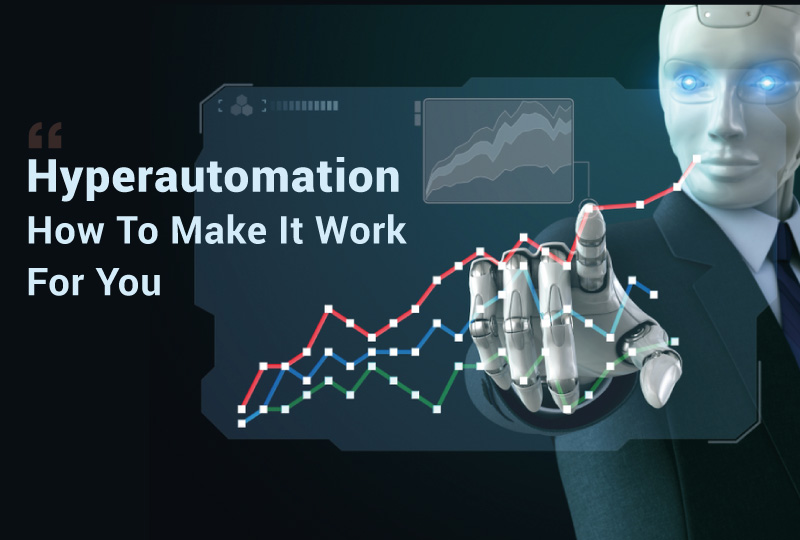The early 2000s were filled with automation. Automate for efficiency, automate for speed, and automate to work alongside humans. Rightly so, that worked extremely well for large scale organizations. In 2020, according to Gartner, Hyperautomation is going to be the buzzword.
Additionally, according to the report by Coherent Market Insights, Asia Pacific has been a leader in Hyperautomation since 2018, and is forecasted to retain its leadership. This is owing to the rapid conversion of traditional ways of working, to automate.
What is Hyperautomation?
Hyperautomation is automation put together with predictive tools such as Robotic Process Automation (RPA), Artificial Intelligence (AI), Machine Learning (ML) and Natural Language Processing (NLP) to automate processes that augment humans.
Today, all large companies are looking for digital transformation – Hyperautomation is one such thing that makes it happen at a high-speed.
Hyperautomation connect applications, understands data, can take decisions based on logic and can even help with predictions. This set of logical processes, managed by software that goes hand in hand with humans.
With Hyperautomation, you can increase efficiency, employee satisfaction, optimize repetitive operations and finally, the bottom line. That being the case, in the instance of time, customer satisfaction can be taken from request-to-resolution.
How To Bring Hyperautomation To Life?
Hyperautomation is along the lines of how you must’ve implemented RPA within your organization.
With Hyperautomation, you need to ask yourself three questions before you begin.
- What is your goal in implementing Hyperautomation? – To increase revenue, to cut down on downtime or perhaps ensure accuracy.
- How are you optimizing? – With Hyperautomation, there is a dire need for structure within the system and flow. That means that you are assessing flows regularly, optimizing to the maximum and then enhancing to boost the same.
- What DigitalOps tools are you going to be using? – This will help you assess time/money/effort in setting up and keeping Hyperautomation running. DigitalOps tools are anything from ‘Business Process Mining’ to ‘iBPMS’ and/or iPaaS.
[Also Read: What is Enabling Hyperautomation in Digital Businesses?]
How Does Hyperautomation Help Business Leaders?
Hyperautomation brings with it several benefits to business leaders looking to scale operations and efficiency.
Some of the benefits of Hyperautomation for business leaders are:
- Performance Metrics: With Hyperautomation and tracking capabilities, you can understand how well you are doing by using the right set of tools.
- Lightning Speed: Since it is machines and processes, the speed is unparalleled when compared with a human.
- Data-Driven Decisions: We’ve progressed from data-backed to data-driven as technology takes a front seat. With Hyperautomation, you can crunch a million lines of data with accuracy, targeted to the results you’re looking for.
- 100% Error-Free: Be it a simple contract that needs to get passed around from finance to legal to marketing or a report for a client – Hyperautomation is error-free, provided the code and tech-backing are strong.
What Do Leaders Need To Prepare For?
Leaders and businesses those are planning to implement Hyperautomation, need to prepare for disruption. Disruption to the way employees/teams interacted and worked. When Hyperautomation is in place, a lot of ‘work’ will be taken off the employee’s hands.
This means that leaders need to be prepared to retool, retrain and reframe how employees and the business work. ‘Quality work’ will be the ‘Future of Work’ with Hyperautomation.
What Is The End Goal With Hyperautomation?
Engaging workers to their fullest potential and capability has always been a challenge for organizations. With Hyperautomation, there is a high chance it could be mistaken for jobs being taken away. However, that is not the case. The idea behind Hyperautomation is to automate more, so more productive work can be done.
Quality of work is a psychological booster and has a very high correlation in boosting employee motivation and morale.
It is for the collective good that Hyperautomation is implemented within organizations that are looking to scale work, employees, processes and more. Redundant work can be handed with robots/digital logic, and humans can go about doing activities that contribute to the bottom line of the organization.
Will Hyperautomation Take Away Jobs?
Absolutely not! No single tool can replace humans. Here, humans play an integral role in the Hyperautomation process. Humans need to start thinking of Hyperautomation as a ‘friend’, which can multiply the power of human productivity.
With Hyperautomation and the varied add-ons, the value-output is extremely large.
Hyperautomation was created to help us work faster and smarter, making work meaningful and allowing to contribute towards things that matter.
How AutomationEdge Can Help Achieve Hyperautomation?
One of the primary attributes of Hyperautomation is its ability to integrate various technologies and advanced solutions to provide a seamless and hassle-free service.
AutomationEdge is a pioneer in offering bundled capabilities like Artificial Intelligence (AI), Machine Learning (ML), Natural Language Understanding (NLU), iPaaS, connectors to packaged applications.
AutomationEdge has been successful in introducing CogniBot, which provides an automated IT and Business process experience with the help of Robotic Process Automation, AI, ML and NLU capabilities.
AutomationEdge AI helps in automation and improvement of various critical processes like customer support, networking, data centre, security and application support. It also enables automated resolution of service desk tickets at a much quicker pace with minimized error.
AutomationEdge is already in the path towards a productive and highly intelligent automated service for enterprises through Hyperautomation.
To see AutomationEdge Hyperautomation capabilities in action, request a demo.
How are you planning to implement Hyperautomation in your organization? Let us know in comments.
